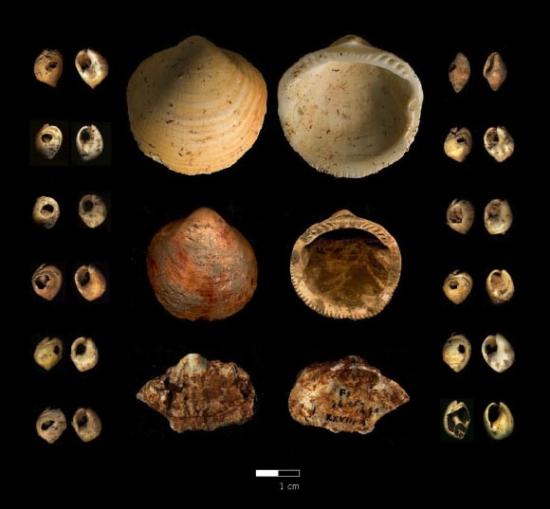Source - http://www.sci-news.com/archaeology/science-early-modern-humans-near-east-01384.html
New radiocarbon dating on seashell beads found at the Paleolithic site of Ksar Akil in Lebanon indicates that the earliest fully modern humans arrived in the Near East around 40,000 BC. This is significant because the age of the earliest fossils of modern humans found in Europe is roughly similar.

Shell specimens from Ksar Akil (Douka K et al).
Dr Katerina Douka from the University of Oxford, UK, and her colleagues from the United States and the Netherlands dated 20 marine shells from the top 15 m of archaeological layers at Ksar Akil. The shells were perforated, which indicates they were used as beads for body or clothes decoration by modern humans. Neanderthals, who were living in the same region before them, were not making such beads.
The study, published online by the open-access journal PLoS ONE, confirms that the shell beads are only linked to the parts of the sequence assigned to modern humans and shows that through direct radiocarbon dating they are between 41,000-35,000 years old.
The Middle East has always been regarded as a key region in prehistory for scholars speculating on the routes taken by early humans out of Africa because it lies at the crossroads of three continents – Africa, Asia and Europe.
It was widely believed that at some point after 45,000 years ago early modern humans arrived in Europe, taking routes out of Africa through the Near East, and, from there, along the Mediterranean rim or along the River Danube.
However, this dating evidence suggests populations of early modern humans arrived in Europe and the Near East at roughly the same time, sparking a new debate about where the first populations of early humans traveled from in their expansion towards Europe and which alternative routes they may have taken.
In Ksar Akil, the Lebanese rockshelter, several human remains were found in the original excavations made 75 years ago. Unfortunately since then, the most complete skeleton of a young girl, thought to be about 7-9 years of age buried at the back of the rock shelter, has been lost. Lost also are the fragments of a second individual, found next to the buried girl.
However, the team was able to calculate the age of the lost fossil at 40,800-39,200 years ago, taking into account its location in the sequence of archaeological layers in relation to the marine shell beads.
Another fossil of a recently rediscovered fragment of the upper jaw of a woman, now located in a museum in Beirut, had insufficient collagen to be dated by radiocarbon methods. A method using statistical modeling was used to date by association the jaw fragment at 42,400-41,700 years old.

Comparison of the modeled ages obtained for two modern humans from Ksar Akil, Lebanon, with age estimates of humans from other Paleolithic sites between 50,000 – 30,000 years ago (Douka K et al).
Ksar Akil is one of the most important Paleolithic sites in Eurasia. It consists of a 23-m deep sequence of archaeological layers that lay undisturbed for thousands of years until a team of American Jesuit priests excavated the rockshelter in 1937-38, and again after the end of the WWII, in 1947-48. The cave layers were found to contain the human fossils and hundreds of shell beads, as well as thousands of stone tools and broken bones of hunted and consumed animals.
“This is a region where scholars have been expecting to find early evidence of anatomically and behaviorally modern humans, like us, leaving Africa and directly replacing Eurasian Neanderthal populations that lived there for more than 150,000 years,” Dr Douka said.
“The human fossils at Ksar Akil appear to be of a similar age to fossils in other European contexts. It is possible that instead of the Near East being the single point of origin for modern humans heading for Europe, they may also have used other routes too. A maritime route across Mediterranean has been proposed although evidence is scarce. A wealth of archaeological data now pinpoints the plains of Central Asia as a particularly important but relatively unknown region which requires further investigation.”
“The earliest European modern fossil, from Romania, dates to between 42,000-38,000 years before the present time, and specialists have estimated the age of Kent’s Cavern maxilla from southern England, between 44,000-41,000 years, and that of two milk teeth in southern Italy, at 45,000-43,000 years old. The new dating evidence from Ksar Akil is largely comparable to these ages, if not slightly younger.”
Bibliographic information: Douka K et al. 2013. Chronology of Ksar Akil (Lebanon) and Implications for the Colonization of Europe by Anatomically Modern Humans. PLoS ONE 8 (9): e72931; doi: 10.1371/journal.pone.0072931